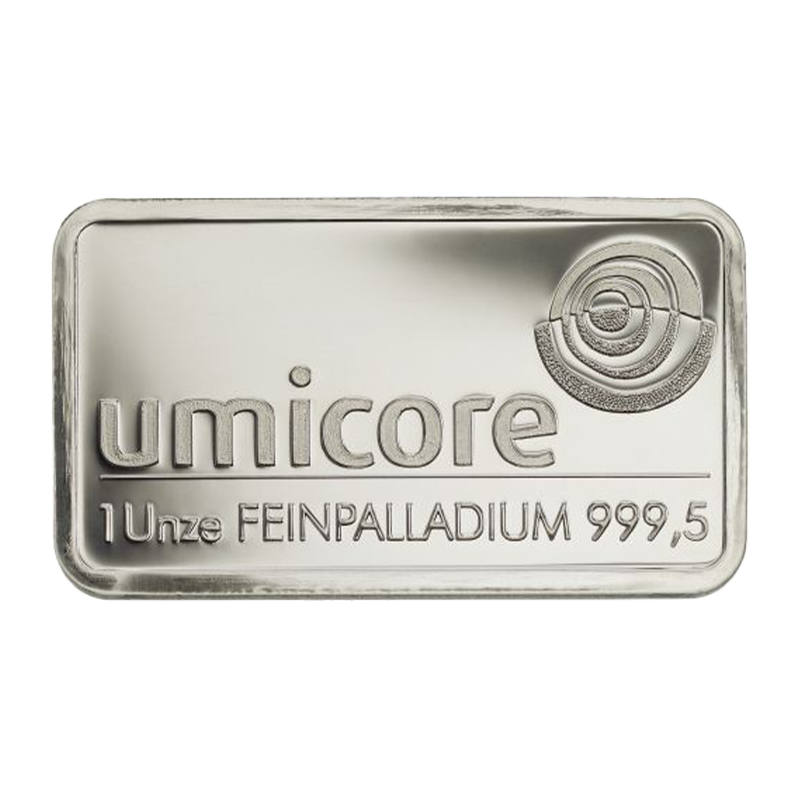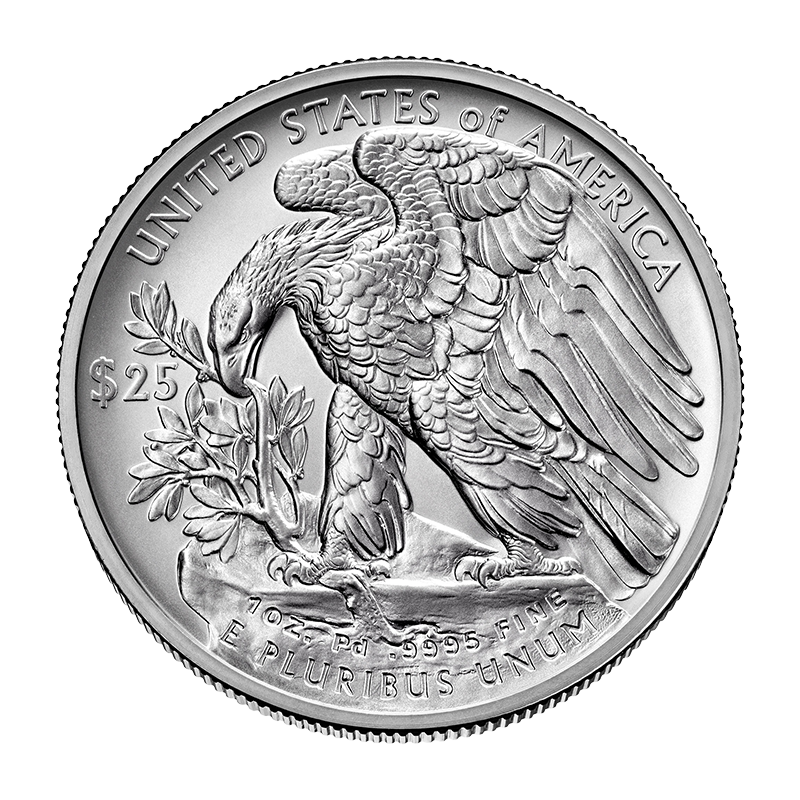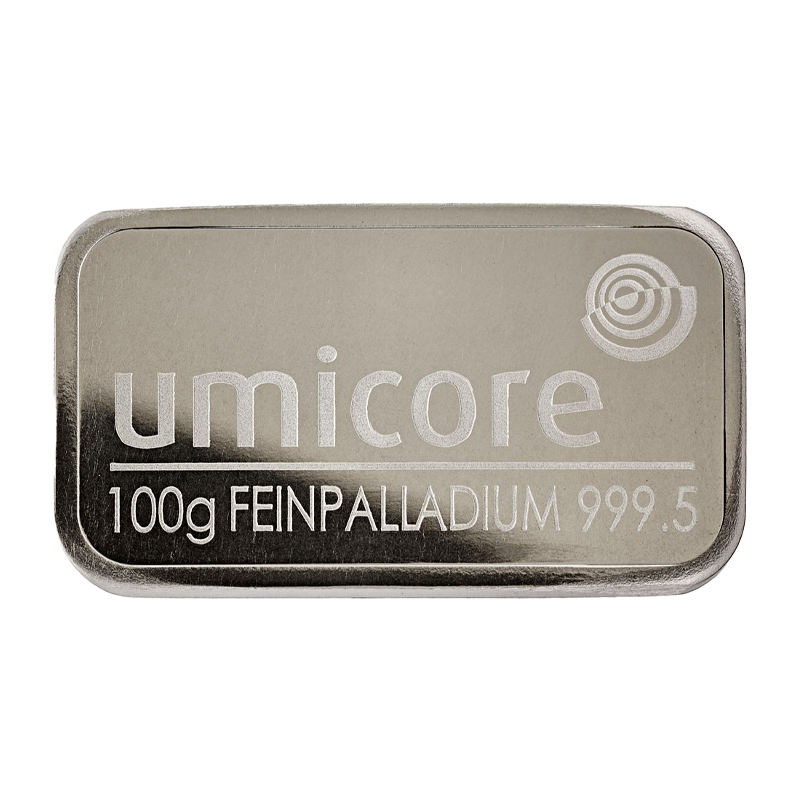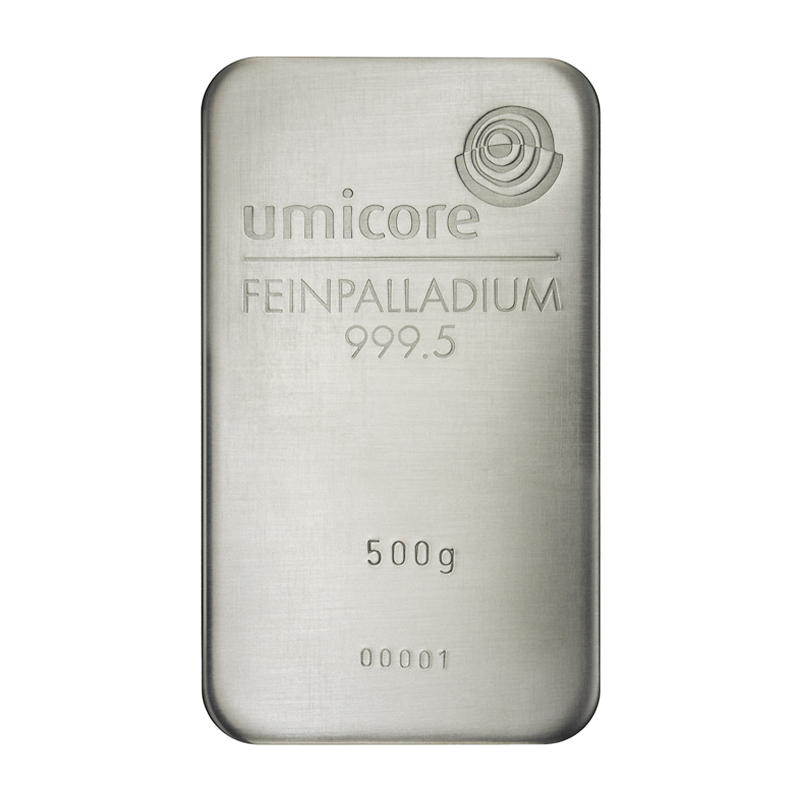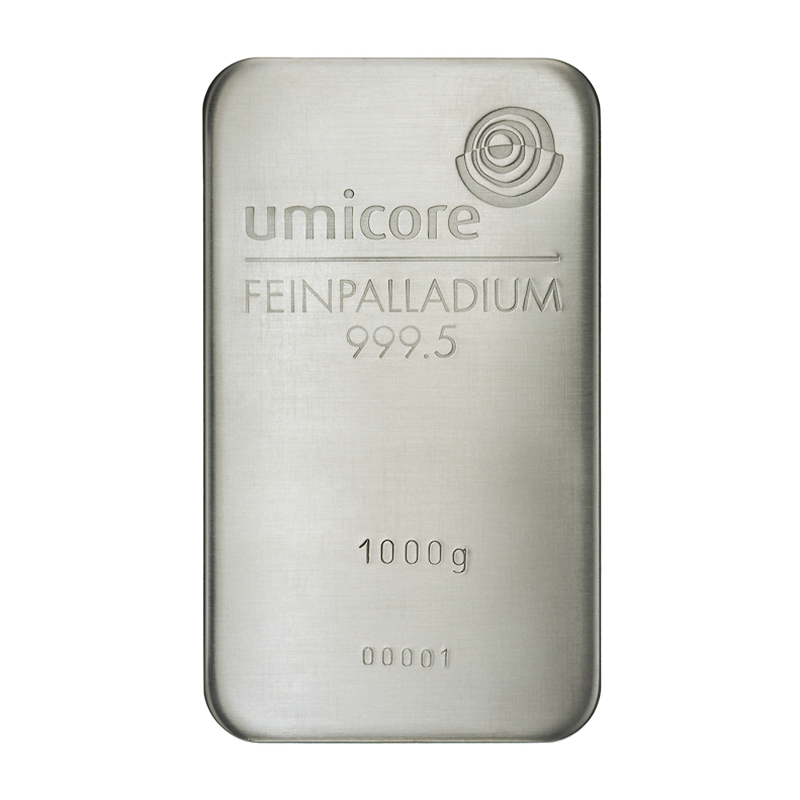Current palladium price 2025
Palladium is one of the most valuable precious metals in the world and is becoming increasingly popular with investors as a commodity. The current palladium price reflects the particular market dynamics of this rare metal, which plays an important role both in industry and as an investment. At Geiger Edelmetalle, you will always receive transparent information on the current palladium price and benefit from our many years of expertise in precious metals trading.
Precious metals prices at a glance:

Interesting facts about the gold price
The gold price reflects the current market value of gold and is subject to constant fluctuations. These are caused by the interplay of global factors such as inflation, key interest rates, geopolitical developments and currency movements. The US dollar in particular plays a key role as the reserve currency, as gold is predominantly traded internationally in USD. Supply and demand on the global market - for example from central banks, investors or the jewellery industry - also have a noticeable influence on the price. A sound understanding of price trends is therefore essential in order to correctly categorise the dynamics of the gold market.
The most important facts in brief
- The price of gold fluctuates daily and is significantly influenced by supply, demand, interest rate policy and geopolitical developments.
- Gold wird international meist in US-Dollar gehandelt, weshalb auch Wechselkurse (insbesondere EUR/USD) eine zentrale Rolle spielen.
- Der Preis bezieht sich in der Regel auf eine Feinunze (ca. 31,1 Gramm) und wird an Börsen wie der New York Mercantile Exchange (COMEX) bestimmt.
- Gold dient vielen Anlegern als krisensichere Wertanlage, besonders in Zeiten wirtschaftlicher Unsicherheit oder hoher Inflation.
What does the gold price say?
The gold price indicates what buyers currently have to pay for a certain amount of gold and is usually based on one troy ounce, i.e. around 31.1 grams. The price is usually quoted in US dollars, as gold is predominantly traded in this key currency on the international commodity markets. However, prices in euros or Swiss francs are also relevant, especially for trading in the DACH region.
In principle, the price of gold reflects the relationship between supply and demand. If demand increases in times of economic uncertainty, for example, or if supply decreases due to limited production volumes, the price can rise accordingly. If, on the other hand, demand falls or there is an increased supply on the market, the price falls.
What influences the gold price?
The gold price reacts sensitively to a variety of macroeconomic and geopolitical factors. Those who are familiar with these correlations can better understand price developments and make well-founded investment decisions. The most important influencing factors at a glance:
Interest rate policy of the central banks
The monetary policy of the major central banks, in particular the US Federal Reserve and the European Central Bank (ECB), is a key factor in the development of the gold price. The key factor here is the key interest rate, which has a decisive influence on how expensive or cheap it is for banks to borrow money and therefore how much interest is paid on savings or bonds.
Negative impact on gold price with rising interest rates
In an environment of rising interest rates, interest-bearing forms of investment (e.g. government bonds) become more attractive as they now offer a measurable return again. In comparison, gold appears less lucrative as an ‘interest-free’ investment, which can reduce demand and thus lead to falling gold prices.
Positive impact on gold price with falling interest rates
Conversely, precious metals gain in importance during periods of low or even negative interest rates. When traditional forms of saving generate little or no income, many investors look for alternatives that retain their value and increasingly want to invest in gold. The result: rising demand, rising prices.
Inflation and economic crises
Gold is traditionally seen as a hedge against inflation. If the cost of living rises noticeably, paper money (i.e. currencies such as the euro or the US dollar) loses purchasing power in real terms. Gold, on the other hand, is a physical asset whose value cannot be arbitrarily diluted by monetary policy measures.
In times of high inflation or impending recession, many investors therefore flee into gold to protect their assets from a real loss in value. Even in times of economic crisis - such as stock market crashes, banking crises or phases of economic stagnation - the need for security often increases. Gold is then perceived as a ‘safe haven’, which drives demand and causes the price to rise.
Geopolitical tensions and uncertainties
Wars, political instability, trade conflicts or natural disasters cause uncertainty on the financial markets. In such phases, confidence in traditional forms of investment or in the functioning of entire economies is often shaken.
Unfortunately, this is not good news, but gold benefits in such situations. This is because it is recognised worldwide as a stable, accepted commodity, regardless of governments or currencies. Even the prospect of an escalation of geopolitical conflicts can increase the demand for gold and lead to rapid price rises.
Exchange rates
The price of gold on international exchanges is generally quoted in US dollars (USD) per troy ounce. For European or Swiss investors, the exchange rate between USD and EUR or CHF therefore plays a decisive role.
Example:
If the US dollar strengthens against the euro, buyers from the eurozone have to pay more euros for the same amount of gold - the gold price in euros rises. Conversely, a weaker dollar can lower the price of gold from the perspective of European investors. Monetary policy and statements by leading central banks therefore also indirectly influence the gold price trend.
Who determines current gold prices?
Gold is mainly traded on major exchanges such as the New York Mercantile Exchange (NYMEX), the Tokyo Commodity Exchange (TOCOM) and the London Bullion Market Association (LBMA).
Prices are determined in real time at these trading centres based on current buy and sell orders. Gold fixing is carried out twice a day in London, where a reference price is set that is particularly important for the jewellery industry.
Milestones for the gold course
The history of the gold price is characterised by strong price fluctuations, historic highs and significant crises. At the same time, it is inextricably linked to the economic and political development of the world.
1979-1989: Gold rush and subsequent correction
At the end of the 1970s, the price of gold experienced an unprecedented rise. On 21 January 1980, it reached a record high of USD 850 per troy ounce. Adjusted for inflation, this corresponds to a value of around USD 2,330 in today's purchasing power. The reasons for this price increase were geopolitical tensions, high inflation rates and economic uncertainties. In the following years, there was a market correction and the price of gold fell to around USD 300 per troy ounce by 1985. By the end of the 1980s, it had stabilised in a range between USD 350 and 400.
1989-1999: Stable phase with moderate downward trend
This decade was characterised by relative stability on the gold market. For the most part, the price fluctuated between USD 350 and 400 per troy ounce. Towards the end of the 1990s, however, a downward trend set in, influenced by a strong US dollar and positive developments on the stock markets. In 1999, the price of gold fell to a low of around 250 US dollars per troy ounce.
1999-2009: Renaissance of gold
From 2000, the price of gold began to rise again. This upswing was fuelled by the bursting of the dotcom bubble, geopolitical uncertainties and increasing demand for safe forms of investment. In 2008, during the global financial crisis, the price of gold exceeded the USD 1,000 per troy ounce mark for the first time, marking a new all-time high. This development emphasised the role of gold as a safe haven in times of crisis.
2009-2019: Record highs and subsequent consolidation
In September 2011, the price of gold reached a new all-time high of around USD 1,920 per troy ounce. This was due to the lingering after-effects of the financial crisis, expansionary monetary policies and concerns about inflation. This peak was followed by a period of consolidation and the price fell to around USD 1,050 per troy ounce by the end of 2015. In the following years, the price of gold slowly recovered and hovered between USD 1,200 and USD 1,500 per troy ounce until 2019.
2019 to date: New heights in uncertain times
The price of gold has been on an upward trend again since 2019. In August 2020, during the COVID-19 pandemic, it reached a new record high of around USD 2,070 per troy ounce. This development was favoured by economic uncertainties, low interest rates and expansionary fiscal policies. Currently, in April 2025, the gold price is trading at over USD 3,100 per troy ounce, which marks new highs in both nominal and inflation-adjusted terms.
The gold market: gold demand vs gold supply
As with any commodity, the interplay of supply and demand determines the price on the gold market. Unlike many other commodities, however, gold is a special market: only a small proportion of the gold ever mined is actually lost. Almost all of it remains in the form of bars, coins, jewellery or reserves. This makes the gold market both more stable and sluggish in response to changes in supply - while changes in demand are sometimes reflected much more quickly in the price.
Gold demand: Who is actually buying gold?
The global demand for gold is made up of several sectors:
- Private investors & investors: They see gold as a crisis-proof investment and protection against inflation. In times of economic uncertainty or falling interest rates, their demand increases noticeably.
- Central banks: Many central banks, especially in emerging markets, buy gold to diversify their currency reserves. Their purchases have a considerable influence on the global market.
- Jewellery industry: Gold is traditionally used in large quantities to make jewellery, particularly in countries such as India and China. Demand here is also highly seasonal (e.g. wedding and festive seasons).
- Technology sector: Although it accounts for a smaller proportion, gold is used in electronics and medical technology because of its excellent conductivity and corrosion resistance.
Gold supply: Where does the gold come from?
The supply of gold essentially comes from two sources:
- Gold mining: The majority of gold traded each year comes from mining. However, mining is expensive, time-consuming and slow to respond to market changes. Even when prices are rising, it often takes years before new mines are commissioned or existing ones increase their capacity.
- Recycling: A flexible addition to the supply is so-called secondary gold, for example from old jewellery or industrial waste. In times of high prices, people are more willing to sell old gold, which increases the supply.
Forecast for the gold price: where will we be in the future?
The price of gold is influenced by a variety of global factors, and current developments could have a significant impact on its future direction. Here are some of the most important aspects.
- Geopolitical tensions: Ongoing conflicts, such as the war in Ukraine, have already led to a rise in the price of gold in the past, as investors increasingly flee to safe investments in uncertain times.
- Monetary policy of central banks: Decisions by the US Federal Reserve (Fed) and the European Central Bank (ECB) regarding interest rates and quantitative easing influence the attractiveness of gold as an investment. Lower interest rates could increase the demand for gold.
- Inflation and economic uncertainties: In times of rising inflation or economic instability, gold is traditionally seen as an inflation hedge and safe haven, which can increase demand and therefore the price.
- Currency developments: Movements in the US dollar have a direct impact on the price of gold, as gold is traded internationally in dollars. A weaker dollar can make the price of gold in other currencies more attractive.

